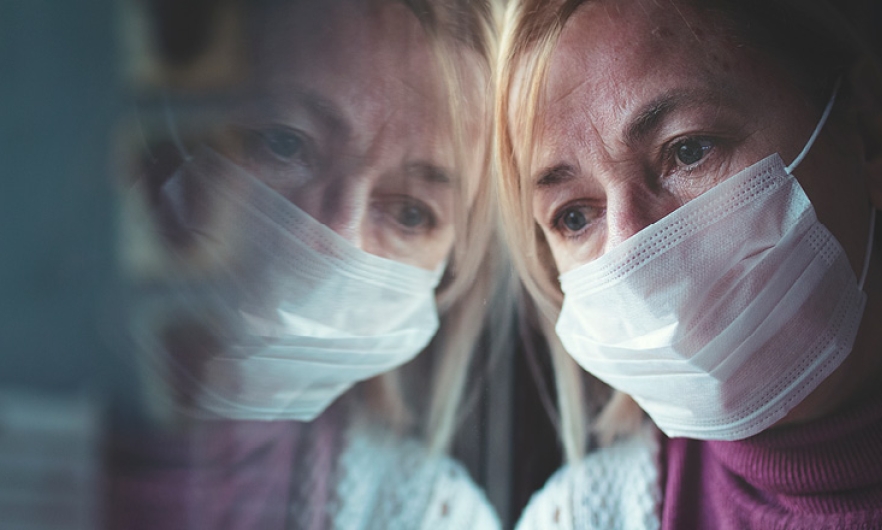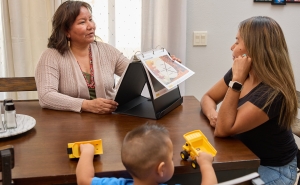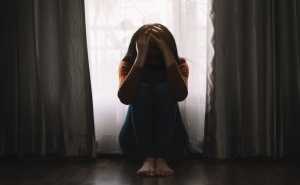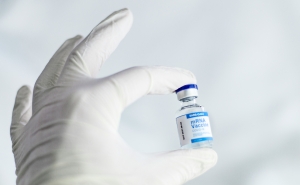Measuring Mental Distress Amid a Pandemic
Understanding COVID-19’s Psychological Effects Over Time

The disruptions of the COVID-19 pandemic—mandatory masks, social distancing, remote school and work—have touched every facet of our lives, including our mental health.
In the early days of the outbreak, mental health experts at Johns Hopkins Bloomberg School of Public Health saw a need to better understand and measure mental distress in the context of a pandemic. To that end, a working group within the School’s Department of Mental Health developed key questions to add to existing large domestic and international surveys to measure the mental health impact of the pandemic.
Some of the initial results of the surveys, which began in March and are continuing, indicate that mental distress has increased in the current coronavirus pandemic, with particularly large increases early on in the states hardest hit.
Contributors to the effort discuss the rationale behind the research initiative and share preliminary results below.
Why is understanding mental distress important?
“We collect these data because we know that stressful things like pandemics affect population mental health,” says Calliope Holingue, PhD, MPH, postdoctoral fellow in Mental Health and the Department of Neuropsychology at the Kennedy Krieger Institute. “The purpose of capturing longitudinal data across time, across sociodemographics, is to see who gets better and why, which helps us design and implement better interventions and treatments.”
“We need to ensure that individuals with need for services receive those, in the current environment,” says Elizabeth Stuart, PhD, associate dean for Education and professor in Mental Health. “To help identify where that need will be, we need good measurement of distress in communities.”
How did the research team develop the survey questions?
The survey questions draw on mental health studies during other large-scale disasters, including the 2003 SARS epidemic. Questions about feelings of anxiety, depression, loneliness, hopelessness, physical reactions to stressors, and existing diagnoses of a mental disorder were adapted and submitted to a number of research surveys, including the Pew Research Center American Trends Panel, the Understanding America Study, and others in the U.S. and abroad.
“The benefit of embedding these measures into existing surveys is that they already collect important data including race, socioeconomic status, employment, even measures on social media use,” says Johannes Thrul, PhD, assistant professor in Mental Health. “Adapting established questions by simply changing the look-back period to seven days, for example, is a very efficient way to look at predictors of higher mental distress during a rapidly evolving situation like this.”
What do the preliminary results show?
- Mental distress in the general population is rising. In early March, hotspot states like California, Washington, New York, and Massachusetts, saw that mental distress significantly increased even after adjusting for factors like age and income. This was a critical time frame to start to understand mental health in the population: a national emergency had just been declared, schools were closing, and workplaces were shutting down. Other states had a smaller increase in distress at that time. However, these geographic differences in mental distress may become less pronounced as the pandemic continues.
- Mental distress is higher in younger individuals than in older populations. Because of medical complications related to COVID-19 among older individuals, researchers expected to see the opposite. Continued data collection is needed to see how age is related to changes in mental health symptoms due to the pandemic.
- The initial survey results also showed that individuals with more frequent use of traditional media (newspapers, TV, radio) and social media had higher levels of mental distress. The findings suggest spending more time engaged with the media may contribute to distress during the pandemic. However, given the restrictions imposed on in-person interactions by social distancing, more research is needed to understand what types of media engagement might be helpful for supporting mental health.
- Individuals who had consumed cannabis and alcohol more frequently in the past week had significantly higher mental distress. Whether the cannabis and alcohol use led to the mental distress, or vice versa, cannot be determined from the current data, but these early results suggest that substance use is not an effective strategy for coping with COVID-19-related stressors.
How do we move forward?
Collecting longitudinal data will be particularly helpful.
“Over time, some people who reported distress earlier on may have other characteristics that allow them to cope better than others,” says Thrul. “Long-term research will help understand and differentiate what may be predictors of a more adverse outcome versus a more positive outcome after an initial distress signal.”
Stuart says other key questions include: “Are there preventive actions we can take right now to improve mental health? How do we ensure individuals get the services they need as the situation evolves? And ultimately, what are the services and treatments that help people manage their current distress, and prevent future problems? That is the type of information we want to learn.”
The Johns Hopkins COVID-19 Mental Health Measurement Working Group includes M. Daniele Fallin, Mental Health chair, Renee M. Johnson, Kira Riehm, Elizabeth Stuart, and Johannes Thrul (Johns Hopkins Bloomberg School of Public Health, Department of Mental Health); Calliope Holingue and Luke Kalb (Johns Hopkins Bloomberg School of Public Health, Department of Mental Health, and Kennedy Krieger Institute); Frauke Kreuter (University of Maryland and University of Mannheim); and Cindy Veldhius (Columbia University School of Nursing).





